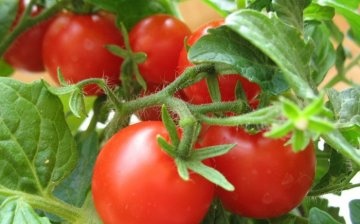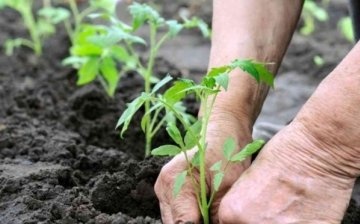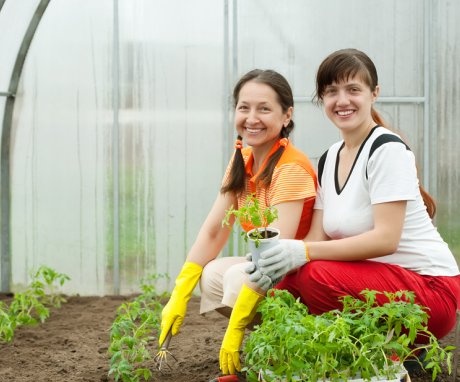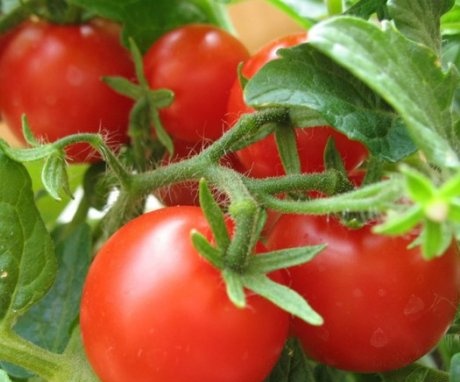Productivity of tomatoes in the greenhouse - varieties and the best tips for growing
Many experienced gardeners choose to grow tomatoes in the greenhouse. Tomatoes are thermophilic, so they grow better in greenhouse conditions and give a higher yield. A large success rate depends on the variety chosen. Every gardener is familiar with the situation when it is not possible to harvest a good harvest, despite excellent care and fertilization. This is due to improperly selected tomato varieties.
Content:
- Which tomato varieties are suitable for greenhouses?
- Features of greenhouse cultivation
- Methods for increasing the yield of tomatoes
- Preparing tomatoes for planting in a greenhouse
Which tomato varieties are suitable for greenhouses?
The yield of tomatoes in a greenhouse depends on many factors, such as the correct care, lighting, watering... First, you should set yourself the task of what exactly the gardener wants to achieve from tomatoes: small fruits for canning, sweet and large fruits for food, or just a large amount of crops for sale. The conditions in the greenhouse are more comfortable, but due to the increased humidity, the probability of various diseases and infections.
Therefore, it is worth choosing only hybrid varieties - they are the most hardy and resistant to pests and diseases.
Tomato varieties for greenhouses:
- For canning and growing in a greenhouse, the varieties "Banana Legs" and "Pink Raisins" are perfect. "Banana legs" are small in size and look very nice in cans, they are bright yellow and elongated. The variety is not aromatic enough for fresh consumption, but perfect for canning. "Pink raisins" are famous for their high yield. These are small and sweet tomatoes, they are well suited for both canning and fresh consumption.
- Among the variety of varieties, you can choose early maturing, early maturing and even ultra-ripe... The latter include "Joy of Summer", "Junior" and "Bear in the North". Tomatoes with the interesting name "Bear in the North" ripen very early. The ripening period lasts about 100 days. They have round red fruits, not too large, sweet. Suitable for both canning and salads. "Junior" matures even earlier, in 80-85 days. These tomatoes grow well both in greenhouses and outdoors. The fruits are bright red, round, medium-sized, sweet. Tomatoes are pest resistant. Up to 2 kg of fruit can be harvested from one bush with proper care.
- The varieties differ in flavor, size and even color. Optionally, you can choose red, yellow, green, pink and even rare black tomatoes called "Black Cherry". Carefully read the description of tomatoes and their properties before buying seed.
Features of greenhouse cultivation
To achieve high yields, you need to know the features of greenhouse growing of tomatoes:
- Greenhouse helps to increase air humidity. This is bad for tomatoes, but good for cucumbers. Therefore, it is not recommended to grow them together in the same greenhouse.
- During the day, the air in the greenhouse can overheat, so it is recommended to ventilate it, and in the summer to open it completely. Airing will also protect from excess moisture, which leads to rotting and other diseases.
- Can be planted the seeds in the greenhouse directly into the ground, if it has warmed up enough. But to increase yields, it is better to grow seedlings at home, and then transplant. Do not keep seedlings at home for more than 50-60 days. She begins to outgrow and take root worse in a new place.
- Plant seedlings it is necessary only in the warmed-up soil. The air temperature should be at least 8 degrees at night and 20 - during the day, and the soil temperature should be at least 15 degrees. The soil temperature should be measured at a depth of 15 cm. Set up the greenhouse in advance so that the soil starts to warm up.
- During flowering tomato the temperature in the greenhouse should be no higher than 35 degrees and not lower than 12, otherwise pollination will not occur and you will be left without a crop.
- The greenhouse cannot be kept in the same place all the time. The soil is the place where the infection accumulates. To keep the harvest high, plant tomatoes better not different locations annually. They grow well after cucumbers, legumes, Luke... But after nightshade, it is better not to plant tomatoes for several years (potatoes, pepper, eggplant).
- Before planting tomatoes in the greenhouse, the soil must be prepared. Check the quality of the soil and add fertilizers that are lacking in it. Then the soil is moistened with warm water and covered with foil for several days. Soil preparation is complete. Now you need to make holes, moisten them with a solution of potassium permanganate and plant seedlings.
- If the seedlings have already been planted, and the air temperature suddenly dropped sharply, you will have to figure out how to artificially maintain the desired temperature in the greenhouse. Otherwise, the harvest can be lost. Tomatoes do not tolerate frost. To do this, you can cover the greenhouse with an additional layer of film. The distance between the layers should have been about 3 cm.
- Do not plant tomatoes too thickly in the greenhouse, they need space. If you often plant it, you will not achieve a high yield. There should be a distance of 25 cm between the bushes, and at least 30 cm between the rows.
Methods for increasing the yield of tomatoes
To achieve great harvest, gardeners apply some tricks. Easy-to-follow tips will help you significantly increase the number of fruits. When tomatoes begin to bloom, they need to be sprayed with a weak solution of boric alcohol. This will help to set the fruit and also improve its taste. In this simple way, you can increase the yield up to 20%.
It is very difficult for plants to pollinate without wind and insects - shake the flowers every few days, water, and after 2 hours, slightly open the film.
Tomatoes must be hilled. If pimples appear on the stem below, it's time to start the procedure. A second hilling should occur when the stem below becomes bluish. This will help strengthen the root system, which means there will be more harvest.
Mulching will help increase yields by 20-30%. To do this, cover the soil with a layer of straw, hay, pine needles or leaves for the best protection. Oddly enough, tomatoes love their own last year's tops. If it is crushed and added to the soil, the plants will be stronger and stronger.
Remove excess shoots so that the plant does not waste energy on them, then more nutrients will flow to the fruits.
To prevent the shoots from growing back, cut them off not completely, but leaving a small stump. When the fruiting period begins, you need to remove the lower leaves. In this way, the fruits will get more strength. In addition, the lower leaves are in contact with the soil and can cause infection. You need to cut off 1-2 lower leaves in dry warm weather. It is better to do this in the morning so that the wounds heal by the time of the hot day.
You need to fertilize not only the soil. The green part of tomatoes also loves feeding. Therefore, once a week, it is recommended to spray the plants with a solution of trace elements. This is done in the evenings in the absence of wind. During the fruiting period, it is especially important feed tomatoes. Ash or yeast can be added to the soil.
Preparing tomatoes for planting in a greenhouse
For a rich harvest, it is not enough to care for already planted plants:
- You need to start from the very beginning - from the seeds. The stronger it will be seedling, the more fruit will grow.
- First, you need to select strong and large the seeds visually, and then soak them in salt water to weed out the empty ones. Those that float must be removed, and the rest must be dried.
- Selected seeds can be soaked in a weak solution of potassium permanganate to kill the infection, if any. It is recommended to do this even with purchased seeds.
- If the seeds are soaked for 8 hours in a solution of wood ash, and then dried, the yield will be higher.
- In order for the seeds to grow stronger, they need to be hardened. Hardening consists in temperature changes. Temperatures should be low to medium, but not high. Place dry seeds in a natural cloth bag and leave at room temperature for 12 hours. Then transfer the bag to the top shelf of the refrigerator, where the temperature is not so low, and leave it there for 12 hours. In this way, move the seeds from cold to warm for two weeks. After that, the seeds should germinate.
- Sowing seed produced 2 months before transplanting to the greenhouse. Care must be taken to ensure that the seedlings do not outgrow.
- The seeds are sown at a shallow depth at a distance of 1 cm from each other. After about 3-5 days, the sprouts should hatch if the seeds have been prepared correctly.
For the seedlings to be strong and take root well, when the first shoots appear, place the boxes in a bright but cool place, where the temperature is no more than 15 degrees.
In the future, the seedlings need standard care: loosening, regular watering once a week, airing.
Two weeks after the sprouts appear, they need to be planted in individual pots. This is done when the first two true leaves have appeared. When transplanting, poorly developed seedlings should be removed immediately. After transplanting, do not place the seedlings in a sunny place. It is better to leave the boxes in the shade for a while. After a week, you can rearrange their illuminated windowsill.
The first feeding fertilizers can be produced one month after planting. This can also be done immediately before planting in the greenhouse. Do not plant seedlings in the greenhouse too early in pursuit of an early harvest. Tomatoes love warmth. Planted plants will die too soon. To harvest early, plant seedlings with the first buds. Non-flowering tomatoes planted in a greenhouse will not bear fruit soon. Compliance with the recommendations will increase the yield and get an excellent result.
More information can be found in the video.

















In my opinion, fast-maturing varieties are better suited for greenhouse cultivation. Therefore, you need to take the varieties "Junior" and "Bear in the North". By planting their seedlings in a greenhouse, you can get tomatoes already at the beginning of summer.